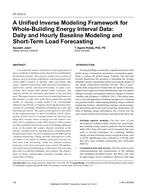Description
A considerable amount of literature on the application ofinverse methods to building energy data has been published inthe last three decades. These inverse models serve a variety ofpurpose such as baseline modeling for monitoring and verification(M&V) projects at monthly, daily, and hourly timescales; condition monitoring; fault detection and diagnosis;supervisory control; and load forecasting, to name a few.Usually, these models have distinct model structures, andseparate models are developed depending on the specifiedneed. This paper proposes a novel inverse modeling frameworkthat attempts to unify some of the above application-specificmodels by allowing a single model to be incrementallyenhanced. Specifically,webegin by clustering the energy intervaldata of a building, identifying scheduling day types andremoving any outliers. This aspect of the analysis is describedin the companion paper by Jalori and Reddy (2015). Subsequently,the first level is to identify models for each day typeusing daily average values of energy use and climatic variables;this is adequate in many M&V projects. These modelsare then extended to hourly time scales by including additionalterms in the model that capture diurnal variations of theclimatic variables and the building hourly scheduling aboutthe daily mean value; this level is appropriate forM&Vand forcondition monitoring. Finally, periodic autoregressive termsare added to the model to enhance prediction accuracy forshort-term load forecasting, useful for demand responseprograms, or for short-term supervisory control. The applicationof the proposed methodology is illustrated with year-longdata from two different buildings, one synthetic (the Departmentof Energy medium-office prototype) building and anactual office building.
Citation: 2015 Annual Conference, Atlanta, GA, Transactions 2015, Vol 121 pt. 2
Product Details
- Published:
- 2015
- Number of Pages:
- 14
- Units of Measure:
- Dual
- File Size:
- 1 file , 5.7 MB
- Product Code(s):
- D-AT-15-013




